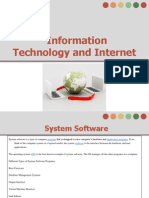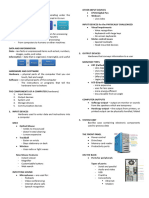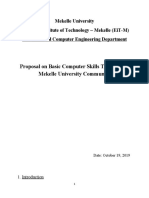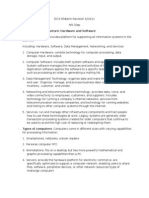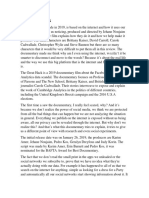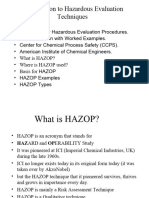Computer Notes
Introduction
• Definition: An electronic device that processes data into information.
• Generations of computers: vacuum tubes to AI-powered systems.
• Applications: communication, education, business, healthcare.
• Definition: An electronic device that processes data into information.
• Generations of computers: vacuum tubes to AI-powered systems.
• Applications: communication, education, business, healthcare.
• Definition: An electronic device that processes data into information.
• Generations of computers: vacuum tubes to AI-powered systems.
• Applications: communication, education, business, healthcare.
• Definition: An electronic device that processes data into information.
• Generations of computers: vacuum tubes to AI-powered systems.
• Applications: communication, education, business, healthcare.
• Definition: An electronic device that processes data into information.
• Generations of computers: vacuum tubes to AI-powered systems.
• Applications: communication, education, business, healthcare.
• Definition: An electronic device that processes data into information.
• Generations of computers: vacuum tubes to AI-powered systems.
• Applications: communication, education, business, healthcare.
• Definition: An electronic device that processes data into information.
• Generations of computers: vacuum tubes to AI-powered systems.
• Applications: communication, education, business, healthcare.
• Definition: An electronic device that processes data into information.
• Generations of computers: vacuum tubes to AI-powered systems.
• Applications: communication, education, business, healthcare.
• Definition: An electronic device that processes data into information.
• Generations of computers: vacuum tubes to AI-powered systems.
• Applications: communication, education, business, healthcare.
• Definition: An electronic device that processes data into information.
• Generations of computers: vacuum tubes to AI-powered systems.
• Applications: communication, education, business, healthcare.
�Hardware
• Input devices: keyboard, mouse, scanner.
• Output devices: monitor, printer, speakers.
• Storage: HDD, SSD, cloud storage.
• Processing: CPU, GPU, RAM.
• Input devices: keyboard, mouse, scanner.
• Output devices: monitor, printer, speakers.
• Storage: HDD, SSD, cloud storage.
• Processing: CPU, GPU, RAM.
• Input devices: keyboard, mouse, scanner.
• Output devices: monitor, printer, speakers.
• Storage: HDD, SSD, cloud storage.
• Processing: CPU, GPU, RAM.
• Input devices: keyboard, mouse, scanner.
• Output devices: monitor, printer, speakers.
• Storage: HDD, SSD, cloud storage.
• Processing: CPU, GPU, RAM.
• Input devices: keyboard, mouse, scanner.
• Output devices: monitor, printer, speakers.
• Storage: HDD, SSD, cloud storage.
• Processing: CPU, GPU, RAM.
• Input devices: keyboard, mouse, scanner.
• Output devices: monitor, printer, speakers.
• Storage: HDD, SSD, cloud storage.
• Processing: CPU, GPU, RAM.
• Input devices: keyboard, mouse, scanner.
• Output devices: monitor, printer, speakers.
• Storage: HDD, SSD, cloud storage.
• Processing: CPU, GPU, RAM.
• Input devices: keyboard, mouse, scanner.
• Output devices: monitor, printer, speakers.
• Storage: HDD, SSD, cloud storage.
• Processing: CPU, GPU, RAM.
• Input devices: keyboard, mouse, scanner.
• Output devices: monitor, printer, speakers.
• Storage: HDD, SSD, cloud storage.
• Processing: CPU, GPU, RAM.
• Input devices: keyboard, mouse, scanner.
• Output devices: monitor, printer, speakers.
• Storage: HDD, SSD, cloud storage.
• Processing: CPU, GPU, RAM.
�Software
• System software: operating systems like Windows, Linux.
• Application software: word processors, browsers, games.
• Programming languages: C, Python, Java.
• Software development lifecycle.
• System software: operating systems like Windows, Linux.
• Application software: word processors, browsers, games.
• Programming languages: C, Python, Java.
• Software development lifecycle.
• System software: operating systems like Windows, Linux.
• Application software: word processors, browsers, games.
• Programming languages: C, Python, Java.
• Software development lifecycle.
• System software: operating systems like Windows, Linux.
• Application software: word processors, browsers, games.
• Programming languages: C, Python, Java.
• Software development lifecycle.
• System software: operating systems like Windows, Linux.
• Application software: word processors, browsers, games.
• Programming languages: C, Python, Java.
• Software development lifecycle.
• System software: operating systems like Windows, Linux.
• Application software: word processors, browsers, games.
• Programming languages: C, Python, Java.
• Software development lifecycle.
• System software: operating systems like Windows, Linux.
• Application software: word processors, browsers, games.
• Programming languages: C, Python, Java.
• Software development lifecycle.
• System software: operating systems like Windows, Linux.
• Application software: word processors, browsers, games.
• Programming languages: C, Python, Java.
• Software development lifecycle.
• System software: operating systems like Windows, Linux.
• Application software: word processors, browsers, games.
• Programming languages: C, Python, Java.
• Software development lifecycle.
• System software: operating systems like Windows, Linux.
• Application software: word processors, browsers, games.
• Programming languages: C, Python, Java.
• Software development lifecycle.
�Networking
• Definition: connecting computers to share resources.
• Types: LAN, WAN, MAN, Internet.
• Protocols: TCP/IP, HTTP, FTP.
• Cybersecurity challenges.
• Definition: connecting computers to share resources.
• Types: LAN, WAN, MAN, Internet.
• Protocols: TCP/IP, HTTP, FTP.
• Cybersecurity challenges.
• Definition: connecting computers to share resources.
• Types: LAN, WAN, MAN, Internet.
• Protocols: TCP/IP, HTTP, FTP.
• Cybersecurity challenges.
• Definition: connecting computers to share resources.
• Types: LAN, WAN, MAN, Internet.
• Protocols: TCP/IP, HTTP, FTP.
• Cybersecurity challenges.
• Definition: connecting computers to share resources.
• Types: LAN, WAN, MAN, Internet.
• Protocols: TCP/IP, HTTP, FTP.
• Cybersecurity challenges.
• Definition: connecting computers to share resources.
• Types: LAN, WAN, MAN, Internet.
• Protocols: TCP/IP, HTTP, FTP.
• Cybersecurity challenges.
• Definition: connecting computers to share resources.
• Types: LAN, WAN, MAN, Internet.
• Protocols: TCP/IP, HTTP, FTP.
• Cybersecurity challenges.
• Definition: connecting computers to share resources.
• Types: LAN, WAN, MAN, Internet.
• Protocols: TCP/IP, HTTP, FTP.
• Cybersecurity challenges.
• Definition: connecting computers to share resources.
• Types: LAN, WAN, MAN, Internet.
• Protocols: TCP/IP, HTTP, FTP.
• Cybersecurity challenges.
• Definition: connecting computers to share resources.
• Types: LAN, WAN, MAN, Internet.
• Protocols: TCP/IP, HTTP, FTP.
• Cybersecurity challenges.
�Future Trends
• Artificial intelligence and machine learning.
• Quantum computing.
• Cloud and edge computing.
• Metaverse and virtual reality.
• Artificial intelligence and machine learning.
• Quantum computing.
• Cloud and edge computing.
• Metaverse and virtual reality.
• Artificial intelligence and machine learning.
• Quantum computing.
• Cloud and edge computing.
• Metaverse and virtual reality.
• Artificial intelligence and machine learning.
• Quantum computing.
• Cloud and edge computing.
• Metaverse and virtual reality.
• Artificial intelligence and machine learning.
• Quantum computing.
• Cloud and edge computing.
• Metaverse and virtual reality.
• Artificial intelligence and machine learning.
• Quantum computing.
• Cloud and edge computing.
• Metaverse and virtual reality.
• Artificial intelligence and machine learning.
• Quantum computing.
• Cloud and edge computing.
• Metaverse and virtual reality.
• Artificial intelligence and machine learning.
• Quantum computing.
• Cloud and edge computing.
• Metaverse and virtual reality.
• Artificial intelligence and machine learning.
• Quantum computing.
• Cloud and edge computing.
• Metaverse and virtual reality.
• Artificial intelligence and machine learning.
• Quantum computing.
• Cloud and edge computing.
• Metaverse and virtual reality.












